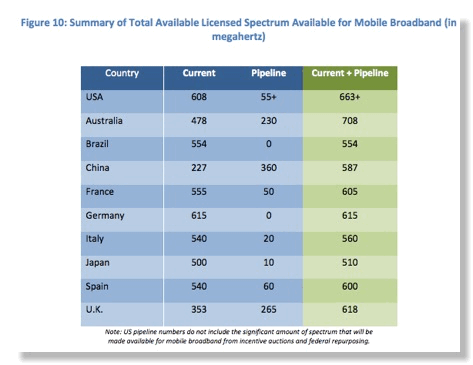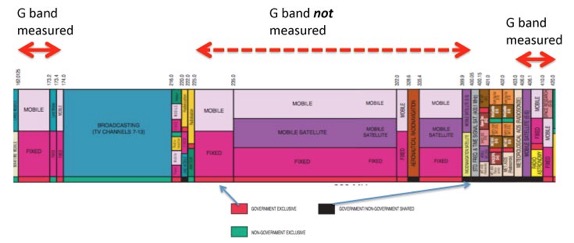Busy Day in Federal Spectrum Management

Among the findings:
- Since 2009, the percentage of American homes reached by high-speed broadband networks have more than quadrupled (from less than 20% to more than 80%) and average broadband speeds have doubled.
- Between 2000 and 2010, the percentage of American households with a home connection to broadband has surged from 4.4% to 67%.
- Annual investment in U.S. wireless networks grew more than 40% between 2009 and 2012, from $21 billion to $30 billion.
In reply to CTIA’s accusations in dueling spectrum charts, the report makes the following statement:
In comparison to other nations, the United States ranks among the top countries in current licensed spectrum available for mobile broadband, and while we cannot predict the amount of spectrum freed by the incentive auctions, this forthcoming spectrum — combined with Federal repurposing — are likely to keep the United States well atop other nations in mobile broadband allocation.
And now the White House adds a new spectrum chart that alleges to show
USA #1!

Now why does the current CTIA “flag chart” show the US as having 409.5 MHz of spectrum while the White House finds 608 MHz is a little mystery as neither side shows their raw data. A minor quip: we showed here in March raw data from Japan that added up to 501.2 MHz for Japanese commercial mobile wireless spectrum, yet the White House chart gives 500 MHz, close but not what your blogger documented with detailed data straight from Japan.
Why don’t both the WhiteHouse/FCC/NTIA and CTIA release the raw data that backs up their numerical spectrum claims? This would end the dueling spectrum chart issue so we can focus on substance.
The report also continues to talk about spectrum sharing, a topic that the cellular establishment dismisses in their quest to maximize use of Chinese electronics that meet 3GPP standards. However, most sharing mechanisms involve decision making at the base stations, NOT in the mobiles. So whatever complexity is involved is not int he mobile which is all CMRS architectures are really slaves to the orders they receive from base stations.
Also released was a Presidential Memorandum to Executive Branch agencies on “Expanding America's Leadership in Wireless Innovation”.
This memorandum creates a “Spectrum Policy Team”. The Chief Technology Officer and the Director of the National Economic Council, or their designees, will co-chair a Spectrum Policy Team that shall include representatives from the Office of Management and Budget (OMB), the National Security Staff, and the Council of Economic Advisers. The Spectrum Policy Team will work with NTIA to implement the memorandum and may invite the FCC to provide advice and assistance.
This appears to be the implementation of Recommendation 5.1 of the PCAST spectrum report that was belittled by the cellular establishment because of its sharing recommendations. (Trivia note: the PCAST report recommended a ‘Spectrum Management Team (SMT)” and we see that in the implementation it became a “Spectrum Policy Team”. Not clear if the semantic difference is important.)
Hopefully this means NTIA and IRAC will get more “adult supervision” than they have been getting in the past in order to focus on national priorities, not necessarily the priorities of the individual IRAC member agencies.
The Memorandum also directs NTIA “in consultation with the Spectrum Policy Team” to produce
“a plan directing applicable agencies to provide quantitative assessments of the actual usage of spectrum in those spectrum bands that NTIA previously identified and prioritized in its Third Interim Report and such other bands as NTIA and the Spectrum Policy Team determine have the greatest potential to be shared with nonfederal users.
As mentioned previously, NTIA and the IRAC members have zero interest in quantifying the actual use of 225-400 MHz in urban areas. We hope that the Spectrum Policy Team will include this band as one that should be quantified.

The Memorandum directs NTIA to “conduct a pilot program to monitor spectrum usage in real time in selected communities throughout the country” and “to require that each agency's regular reviews of its frequency assignments include a quantitative assessment of its actual usage of spectrum under such assignments”.
Part of the Memorandum is nonbinding “advice” to FCC, an independent agency:
Performance Criteria for Radio Receivers. The FCC is strongly encouraged, in consultation with NTIA, where appropriate, the industry, and other stakeholders, to develop to the fullest extent of its legal authority a program of performance criteria, ratings, and other measures, including standards, to encourage the design, manufacture, and sale of radio receivers such that emission levels resulting from reasonable use of adjacent spectrum will not endanger the functioning of the receiver or seriously degrade, obstruct, or repeatedly interrupt the operations of the receiver. In developing such a program, the FCC is strongly encouraged to give due consideration to existing policies and prudent investments that have been previously made in systems, including receivers. In its consultation with the FCC, NTIA shall provide information regarding Federal receiver standards and agency practices under those standards.
As previously discussed here, NTIA for over 20 years has been condoning FAA’s unwillingness to implement ICAO receiver immunity standards for ILS receivers that greatly impact FM broadcasting licensees. The hard technical part of receiver standards is creating the standard. But int he case of ILS receiver standards that was done in a multistakeholder process manage by the former CCIR (now ITU-R) and ICAO in the 1990 time frame. But the really hard part is really recognizing the economic externalities involved: in many cases the party that has to buy the improved receiver is not the one who gets the benefit. This is why AOPA vehemently opposes ILS receiver regulation.
NTIA and FAA have been publicly silent on this issue for a long time. “What’s fit for the goose, is fit for the gander.” As part of this reexamination of receiver standards FAA and NTIA should publicly state what they think the issues are with respect to implementation of the ICAO ILS receiver standard and what action, if any, they plan to take.
Finally NTIA and NIST announced plans to establish a National Center for Advanced Communications in Boulder, Colorado. The two agencies recently signed a Memorandum of Understanding (MOU) to collaborate on the establishment of the center. The MOU states that the center will leverage the “critical mass of NIST and NTIA research and engineering capabilities concentrated in Boulder” to form a “unique national asset,” and includes the infrastructure and collaborative environment needed to address a wide range of advanced communications challenges. This joint effort will increase the impact of existing efforts already under way in both agencies.
It is ironic that the present ITS was part of NIST’s predecessor, NBS, until NTIA was created in 1978. ITS, basically a contract research operation for other agencies with little funding of it own, was split from the collocated NBS/NIST in order to give a critical mass to what became NTIA when the last of the Office of Telecommunications Policy was moved out of the White House in Executive Order 12046. This with the creation of the Spectrum Policy Team and the ITS/NIST collaboration a key impact of yesterday’s actions is a move to start to undo the changes of 1978 which in retrospect were not successful.
UPDATE
On this busy day there was conference at Georgetown University entitled “"Optimal Coevolution of Mobile Broadband Technology and Spectrum Policy”. The conference was rather one sided focusing on the concerns of the cellular interests and their usual demands for more spectrum and reallocation vs. sharing. However, several of the speakers discussed the Executive Branch releases of the day. Introduction is below. All videos are here.
UPDATE 2
See http://www.marcus-spectrum.com/Blog/files/SpecMeasCorr414.html



![Validate my RSS feed [Valid RSS]](valid-rss-rogers.png)

